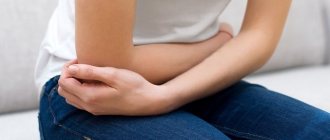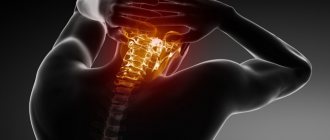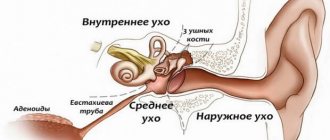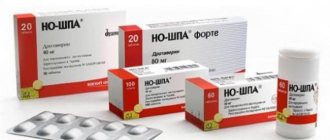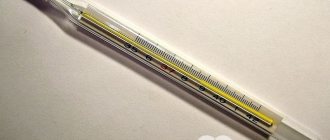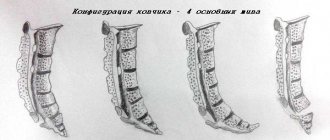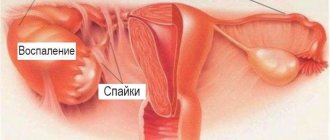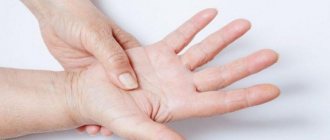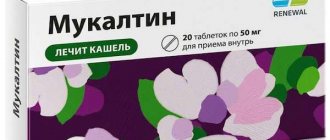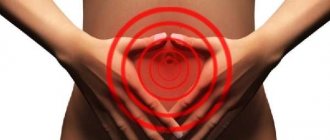Pressing cephalalgia in the temples can occur at any time of the day. This pain is usually of mild or moderate intensity. It does not always indicate the presence of diseases or serious problems, but if it appears systematically, it requires diagnosis. There are many effective ways to deal with unpleasant sensations of a physiological nature. If their use does not give the desired result, you should not resort to taking medications. It is better to visit a neurologist who will determine the causes of the condition and select the necessary treatment regimen. You should not delay your visit to the doctor if there is pressure in your temples and additional alarming symptoms appear.
Nature of headache in the temple area
Headache in the temples has a varied nature in its manifestations.
There are acute and chronic forms of this pathology.
Acute pain appears due to the action of an exogenous factor and is not associated with a pathological process. Symptoms are quickly relieved with pain medication.
Chronic headaches occur on a regular basis and last for a long time. It is caused by endogenous reasons.
In addition, temporal headaches are divided into primary and secondary.
It becomes primary when it acts as a separate symptom or reaction to a stimulus.
A secondary headache is a consequence of another disease.
Temporal headache has the following character:
- Unilateral – pain is localized either in the right or left temple;
- Bilateral – both temples hurt;
- Pulsating;
- Shooting;
- Pressure – the patient feels strong pressure on the right and left temple;
- Dumb;
- Acute;
- Short-term - the attack lasts only a few minutes;
- Long-term – pain torments a person for hours or days.
Complications and prevention
If the pathological process is untimely or incorrectly treated, patients develop serious complications. Due to strong pulsation in the head, disorders appear that are of a mental nature. Patients complain of decreased quality of hearing and vision. A common complication of the pathology is stroke. Irrational therapy of the pathological condition leads to myocardial infarction. Patients' emotional state changes, which is accompanied by mood swings, apathy, and irritability.
To avoid the appearance of pulsation, it is recommended to carry out its prevention, which consists of following certain rules:
- It is recommended that a person get adequate sleep, the duration of which is 8 hours.
- It is recommended to give up bad habits - smoking and drinking alcohol.
- If a person leads a sedentary lifestyle, then he should regularly do eye and body exercises.
- To avoid the development of the disease, it is recommended to ensure moderate physical activity.
- A person should take a walk in the fresh air every day. The duration of the walks is at least 30 minutes.
- An excellent preventive measure is following a daily routine.
- The patient is advised to provide a healthy diet. He should eat vegetables, fruits and grains. It is strictly forbidden to eat fatty, fried, smoked and salty foods in large quantities.
Pulsation in the head area occurs when a person’s lifestyle is incorrect. It can be a symptom of severe and serious diseases. If throbbing pain occurs, the patient is advised to consult a doctor, who will prescribe effective treatment after diagnosis. Symptom therapy is aimed at relieving it and eliminating the causes of its occurrence.
Causes of temporal pain
Pain in the temples is caused by two groups of factors - exogenous and endogenous.
Endogenous causes:
- If a person has a headache in the temples, there is a risk of increased intracranial pressure.
- A sharp and prolonged increase in blood pressure causes severe pain in the temples.
- Age-related metamorphoses of the vascular system, decreased elasticity of capillaries.
- Migraine. Appears in the morning, after waking up. It occurs on one or both sides. Along with temporal pain syndrome, there is pain in the eyes, increased sensitivity to light and loud sounds. Possible increased pain when walking and physical activity. Lasts up to several days.
- Mechanical head injuries - blows, concussions - always provoke intense temporal pain.
- Severe vasoconstriction or impaired blood circulation in the brain.
- Benign or malignant tumors. Any neoplasm has a compressive effect. Malignant tumors cause intoxication and metastases.
- Adrenal pheochromocytoma. An increased concentration of the hormone adrenaline causes severe temporal pain. This is accompanied by nausea, sweating, and frequent pallor.
- Problems with the functioning of the adrenal glands or pituitary gland. At the same time, the level of the stress hormone cortisol in the blood increases sharply. Its action causes temporal headaches.
- If no disorders of the cardiovascular and nervous system are detected, but the patient still has pain in his temples, he should be checked for the presence of pathologies of the temporomandibular joint. They are accompanied by teeth grinding and increased jaw tone.
- Damage, inflammation or damage to the trigeminal nerve often causes headaches in the temple area. Problems with it appear after suffering neck pathologies or spinal injuries. In this case, noise effects may be added.
- Pinched nerves.
- Anemia. A decrease in the number of red blood cells (erythrocytes) leads to brain hypoxia. With anemia, the pain loses intensity in a supine position.
- Hormonal imbalance during pregnancy, menopause or premenstrual syndrome are also accompanied by headaches in the temples, mainly on the right side.
- A bacterial or viral infection causes a headache in the temples. Its intensity increases with the development of the disease. This happens with sinusitis, meningitis, influenza, and sore throat.
- Dental problems. With neuralgia or tooth pulpitis, pain can radiate to the temporal region of the head, especially if wisdom teeth are affected. The pain intensifies during chewing movements.
- Acute or chronic diseases of the ENT organs. Adenoiditis often causes severe pain in the temple area. Most often, children are affected by this pathological condition.
- Decrease in usual indicators of intracranial pressure. In this case, the pain in the temples becomes dull or aching. There are disturbances in the functioning of the auditory and visual analyzers.
- Increase in usual indicators of intracranial pressure. Accompanied by tinnitus. Mainly found in overweight people.
- Reduced tone of venous or arterial vessels. In this case, headaches in the temple area radiate to the back and other areas of the head. Sometimes there is a loss of sensation in the limbs.
- If a person has a headache in the temples, this may indicate inflammation of the epidermis of the temporal or carotid artery (temporal arteritis). Occurs in old age. Accompanied by throbbing pain and hyperthermia. It worsens when talking, chewing movements, lying down, touching the temples. Intensifies in the evening and night hours.
- Temporal pain is a sudden cessation of drinking alcohol after prolonged use.
- The source of pain in the temples is the development of atherosclerosis. The vessels of the brain are affected by excess cholesterol and reduce their area. This causes pressing or throbbing pain in the temples, impaired heart function, and fatigue.
- Autonomic pathologies, vegetative-vascular dystonia.
Temples hurt - what to do?
In case of a one-time occurrence of unpleasant sensations of mild or moderate severity, you can try to cope with the problem yourself. Sometimes, to eliminate discomfort, it is enough to take a walk in the fresh air, drink a cup of chamomile tea, massage your temples, or rub a drop of menthol oil into them. If you still have a headache in your temples after this, you can take a tablet of Ibuprofen, Paracetamol or Citramon.
In other cases, the treatment method depends on the causes of cephalgia:
- hypertension - diet, taking antihypertensive drugs, removing excess fluid from the body, restoring vascular patency, improving blood circulation in the brain;
- migraine – pain relief with the help of NSAIDs, analgesics, triptans, ergotamines;
- neurocirculatory dystonia - taking natural sedatives or light tranquilizers in case of their low effectiveness.
- transient causes - elimination of the irritant, pain relief with any available medications.
Once the discomfort has been eliminated, the treatment does not end. It is necessary to select an appropriate method of preventing temporal cephalgia so that attacks do not recur.
External factors causing headaches in the temples
Exogenous factors:
- Prolonged stress or overwork;
In this case, the pain is squeezing or aching in nature;
- Prolonged hunger or strict diet;
- Sleep disturbance;
- Excessive consumption of foods containing monosodium glutamate (chips, sauces, spices) or nitrites (chocolate, fast food, smoked meats);
This chemical, accumulating in the body, causes pain in the frontal and temporal region;
- Poisoning by chemical compounds. Pain in the temples occurs on both sides and is accompanied by pressure in the back of the head and forehead. Severe poisoning can cause chronic pain;
- Reaction to new climatic conditions or weather changes, weather dependence;
- Climbing to great heights. This causes an increase in blood pressure. Normally, when the exogenous factor is eliminated, the pain stops.
Headaches due to increased intracranial pressure
Localization of headaches
Headache can occur due to increased intracranial pressure. It increases due to an increase in the volume of substances contained in the skull. Blood, tissue or cerebrospinal fluid tend to rush in some cases, causing pain. This occurs with traumatic brain injuries, brain tumors, and meningoencephalitis. The pain in this case is of strong or moderate intensity and can be felt in the temples or forehead, less often in the back of the head. Vomiting, nausea, and severe deterioration in general health may occur. In this case, emergency medical attention is required. It is first necessary to assess the localization of pain and determine the causes of its occurrence. If there was a head blow or injury before, you need to call an ambulance.
How to get rid of headaches in the temples?
If, after eliminating the external factor, attacks of pain in the temples do not stop, if the temporal pain is long-lasting and intense and significantly reduces the quality of life, you need to consult a qualified doctor for examination and consultation. A neurologist or local therapist will help here.
Medications
Depending on the root cause, specialists prescribe analgesic, diuretic, non-steroidal, antibacterial, sulfonamide, and antihypertensive drugs. Sometimes a person needs medications to improve blood circulation to the brain or regulate intracranial pressure.
Painkillers include Nurofen and Ibuprofen. They relieve short-term headaches.
And Amigrenin and Zomog relieve intense pain.
Diuretics include Glycerol or Diacarb. These drugs help reduce intracranial pressure.
Non-steroidal ones - Tempalgin, Clofezon. Helps with migraines or pain caused by exogenous causes.
Antibacterial - “Ingalipt” or “Streptocide”. Similar medications are indicated for viral or bacterial infections.
Enalapril, Anaprilin, Nifedipine lower blood pressure.
"Picamilon", "Cavinton" normalize low cranial pressure.
At home
If during a painful attack it is not possible to treat with medication, you can alleviate your condition by taking a contrast shower or a warm bath. If desired, add pine needles or salt. This restores blood circulation and helps reduce pain. In addition, water is an excellent relaxant. It has cleansing and renewing properties.
It is useful to take a half-hour walk. It will saturate the blood with oxygen, relieve stress and restore blood flow in all parts of the body.
Helpful information
If the pain in your temples is caused by strong stress factors, you need to lie down and turn on calm music for meditation. After about an hour of such rest, your physical and mental state will become much better.
Head massage has proven itself well. If desired, essential oil is used during it. You need to take a comfortable position and lightly massage your head with your fingertips. It is better to start the massage from the most painful area. Each point needs to be massaged for 5 minutes. Then you need to capture the remaining zones. After the massage procedure, it is useful to lie down for some time.
It needs to be done several times a day.
If you do not have high blood pressure, it is recommended to drink hot coffee or tea.
If none of the methods have any effect, you should try just going to bed. Sleep restores the nervous system, psyche, relieves stress and normalizes hormone levels.
Folk remedies
They are effective for short-term headaches. For secondary headaches, traditional methods will only temporarily relieve the symptom.
These include inhalations, herbs, massage, the use of various decoctions, and compresses.
Herbal teas based on chamomile, mint, ginger, lemon balm, and cinnamon are perfect. They have a relaxing effect.
A quick effect is achieved by consuming linden decoction.
You can make a compress from cabbage leaves. Crumple them, apply to the temple area and secure with a bandage.
People suffering from headaches in the temple area may benefit from breathing in the scent of peppermint and lavender oils. In addition, it is recommended to rub the temple area with them.
But we must remember that this brings the desired effect only in moderate doses.
For throbbing pain, it is effective to apply lemon zest to the right and left temple.
To relieve temporal headaches, you need to prepare potato, beet or carrot juice. Drink half a glass 2 times a day.
During pregnancy and temporal headaches, instead of caffeine-containing drinks, it is better to drink an infusion of rose hips.
If you suffer from pain in your temples for a long time, it is recommended to wet a woolen cloth with vegetable oil and vinegar solution and fix it on the frontal and temporal parts of the head.
What traditional medicine offers:
- use of aromatic oils. The effectiveness of aromatherapy has been proven for a long time. Using peppermint oil or lavender oil for painful attacks gives good results. The oils can be used individually or mixed by adding the same portion of peppermint oil to the lavender oil. The oil or aromatic mixture can be inhaled or acupressure done with it in the temple area;
- white cabbage compresses. This proven remedy was known to our ancestors. White cabbage has many healing properties: it relieves inflammation, treats thermal burns, and can reduce pain. Leaves of fresh cabbage need to be lightly beaten with a knife so that the juice appears, applied to the temples, apply a fastening bandage, and periodically replace the leaves with fresh ones;
- valerian root. Decoctions made from this medicinal plant help in many cases. They are also effective for severe headaches. Preparation: Add a tablespoon of finely chopped plant roots to a glass of hot water. Pour the mixture into a thermos and leave for about an hour. Strain and take before meals 3 times a day, dividing the resulting decoction into three equal parts. The duration of treatment is at least seven days.
Tips for preventing temporal pain
- Compliance with work and rest schedules;
- Relaxation, meditation;
- Maintaining an active lifestyle;
- Regularly undergoing scheduled medical examinations and laboratory tests;
- Timely treatment of neurological diseases;
- Proper nutrition with moderate amounts of fatty foods and alcoholic beverages;
- Introduction of herbal tea into the diet;
- A healthy night's sleep for 8 hours.
A harmonious work and rest schedule, the ability to cope with stress, the use of various folk remedies, regular exercise, timely diagnosis and appropriate treatment of chronic and concomitant diseases will help you quickly and permanently get rid of pain in the temples.
Diagnosis of pathology
If the temple often pulsates, the patient is recommended to seek help from a neurologist. The specialist will examine the patient and study the clinical picture, which will allow him to determine the cause of the disease. In order to confirm a preliminary diagnosis, the person is prescribed additional tests:
- General blood test, which shows a detailed leukocyte picture. Thanks to this diagnostic method, it is possible to eliminate the possibility of an inflammatory process in the body. Inflammation in the human body is accompanied by an increase in the erythrocyte sedimentation rate.
- A biochemical blood test to determine cholesterol levels. Thanks to this study, atherosclerosis is determined.
- Computed and magnetic resonance imaging. Thanks to special devices, it is possible to determine malignant and benign tumors in the brain. The methods determine diseases such as aneurysm and atherosclerotic vascular lesions.
- Ultrasound of the brain. Using this method, atherosclerotic plaques and vascular spasms are detected.
- Daily monitoring of blood pressure indicators. Provides the ability to determine arterial hypertension.
If necessary, the doctor may prescribe electroencephalography, rheoencephalography and other manipulations.
For throbbing pain in the temple, it is recommended to use a set of diagnostic measures, which will make it possible to establish the cause of the disease and prescribe effective therapy.
Possible consequences
When pathological symptoms appear, it is important not only to relieve throbbing pain in the temporal region, but also to identify why it appeared. This is necessary to completely eliminate such manifestations. After all, leaving symptoms without proper attention can lead to the following complications:
- sleep disorders;
- decreased vitality, lethargy;
- psychological problems;
- decreased hearing, vision and smell;
- hemorrhages.
It is worth noting that the patient generally feels worse, he develops apathy and detachment from the outside world.
Diagnostic measures
A patient with a neurological or vascular problem must undergo consultation with specialists. Among them:
- neurosurgeon;
- psychiatrist;
- angiosurgeon;
- therapist;
- ophthalmologist.
Laboratory and instrumental research methods are required, including:
- General and biochemical blood test.
- Lipidogram.
- X-ray of the cervical spine.
- CT scan.
- MRI.
- Vascular duplex.
- REG.
Timely seeking help will reduce the risk of complications, and in some cases the situation can save the patient’s life.
Medicines to treat throbbing pain
- If the cause is high blood pressure, antihypertensive drugs are indicated - enalapril, farmadipine, lozap, furosemide.
- To eliminate vascular spasm, you can drink an antispasmodic, for example, no-shpu or drotaverine.
- Migraine attacks are relieved with sumatriptan, dihydroergotamine, and indomethacin.
- Headache caused by stress is treated with sedatives - phytosed, valerian, tincture of peony, motherwort, novopasit, bifren, etc.
Remember that only a doctor can prescribe all medications. You should not self-medicate. The cure for poison differs only in the dose!
Severe headaches and nausea: what to take
In 50-60% of cases, it is after waking up that attacks resembling a migraine begin. A person who drinks regularly has a headache, forehead, neck and temple pain in the morning, and often feels nauseous. These signs indicate serious vascular diseases, trigeminal neuralgia, which provokes acute sensitivity of the brain, spinal cord, and temporal region. Most often, this is the source of why, after alcohol such as champagne and red wine, the head also splits, feels dizzy and hurts.
In this case, it is better to take a drink from a teaspoon of baking soda dissolved in a liter of warm water, or drink 15 drops of ammonia added to a glass of cool liquid. Kefir or fermented baked milk helps a lot.
If a migraine is accompanied by vomiting, and your stomach also hurts after drinking alcohol, you need to drink a glass of boiling water with a spoonful of honey every half hour.
The cocktail will also save you from nausea and hangover. To prepare it you will need a tablespoon of vinegar, salt and pepper, and a beaten egg.
In order for the heaviness in the stomach to go away, the urge to vomit to stop, and the headache to stop hurting, you can drink a drink made yourself from ginger root. Finely chop the root part and pour boiling water over it. Leave for 20-30 minutes and take without adding sugar.
Factors that provoke discomfort
Experts identify the reasons that cause pain in the temples, depending on external stimuli or people’s lifestyle:
- Overwork and lack of sleep lead to the feeling of hammers knocking in your temples and your head being squeezed by a hot hoop.
- Intoxication of the body due to food poisoning. It is characterized by general weakness, dull, jerking pain in the temporal region.
- Alcohol poisoning. Accompanied by nausea, dizziness, heaviness in the liver and stomach. Typically, discomfort in the temporal area is noted in the morning; as the day progresses, the condition may worsen. The pain intensifies in bright light, loud sounds, and a feeling of tightness in the head appears.
- Poisoning by toxic fumes: from building materials used to decorate the house, furniture polish, glue, toys, low-quality linoleum, stretch ceiling fabric.
- Pain in the temples is caused by eating foods that contain the food additive monosodium glutamate: sauces, overcooked nuts, seasonings, spices, salami sausage, smoked fish, etc.
- Prolonged fasting. If you refuse to eat for 24 hours or more, you may develop hunger headaches in the area of the eyebrows and temples.
- Changes in altitude have a negative impact on people's well-being. Many people complain of discomfort in their temples on an airplane when ascending to a significant altitude (more than 4000 meters). Temporal pain is noted by scuba divers who have descended to a depth of more than 400 meters.
Carbon monoxide poisoning can provoke severe pain in the temples. Gas is released if you close the stove damper without allowing all the coals to burn out. If you experience a general headache, a feeling of heaviness in the head, or drowsiness, you need to urgently ventilate the room and call an ambulance.
Diagnostics
Which doctor should I contact? If a person has pain in his temples and eyes, the first thing he should do is visit a therapist. After listening to the patient’s complaints and examining him, the doctor will prescribe treatment or refer him to another specialist: a neurologist or ophthalmologist. Additionally, the following types of examination are prescribed:
- Magnetic resonance or computed tomography of the head and neck.
- Angiography of cerebral, temporal, and ophthalmic arteries.
- Ophthalmological examination.
- Fundus examination.
If necessary, a general blood test is taken to determine whether the level of sugar and cholesterol is in the normal range.
What examinations should you undergo?
First of all, contact your family doctor. He will conduct a survey and collect data on your life history and illness. He will examine the skin, check reflexes, and measure blood pressure. Based on the data received, the doctor will think about why you are experiencing pain and what tests and studies should be prescribed for you.
- General blood analysis. It will show the level of hemoglobin, ESR (if erythrocyte sedimentation is accelerated, you can think about the inflammatory process). A change in the leukocyte formula, the presence of young cells indicates oncopathology.
- Blood sugar test.
- Biochemical blood test for cholesterol.
- CT scan.
- Dopplerography is an ultrasound examination of the vessels of the brain and spinal cord.
The doctor prescribes tests according to indications.
When to see a doctor immediately
If you have persistent headaches, it is important to tell your doctor about any bothersome symptoms. Before diagnosing and establishing a diagnosis, do not self-medicate under any circumstances. It is especially dangerous to take drugs that lower or increase blood pressure without the advice of specialists.
If the following emergency situations occur, it makes sense to immediately seek help:
- Pain in the temples is long-lasting and cannot be relieved by antispasmodics and strong painkillers.
- There is a feeling of an explosion occurring in the head. In this case, there is a decrease in hearing, vision, speech impairment, and coordination.
- Throbbing pains become paroxysmal. Each time the knocking gets louder.
- The unpleasant sensations in the head are accompanied by vomiting, which does not bring relief.
- The patient notes increased pain during physical activity.
- The body temperature has increased, the neck is limited in movement, and changing the position of the head causes unbearable pain.
- Increasing pressure above 150/100 mm. RT. Art.
After collecting an anamnesis, the patient is prescribed examinations to identify the cause of pulsations and accompanying symptoms.
Why does pulsation begin in the temples?
Cephalgia is caused by various diseases:
- Brain.
- Thyroid disorders.
- Spinal diseases.
- Atherosclerosis.
- Arthritis.
Even if the pain goes away on its own, it should not be ignored. It is better to consult a doctor, undergo the necessary examination and begin treatment. The appearance of pain in the temple area is associated with nerve endings located in the neck, jaws and upper back. They all connect to nerves running in the temporal and frontal lobes. Any irritation leads to a headache.
The pulsation of the temples begins with an increase in blood pressure, affecting the walls of blood vessels. This can happen when the vascular bed spasms or an excess amount of blood circulates in it. This is an extremely unpleasant sensation for patients. Pressing, throbbing pain that causes discomfort in the temples, interferes with work, doing household chores, provokes irritability, and depresses the psyche.
Treatment
When there is throbbing in the temples and a headache, the patient tries to calm the attack with all possible methods. Persistent aggressive pain in the temples with vegetative pathologies should not be treated independently. To select medications and methods of therapy, it is better to consult a doctor.
A moderate attack can be suppressed with a one-time dose of analgesics, using folk remedies, and physical therapy. If the pain returns after the drug wears off, you should consult a doctor. Addiction to analgesics often causes the development of chronic cephalgia with a pulsating character.
Medicines that relieve pain
The main substances included in headache medications are:
- Analgin , dulling the pain impulse, acting on the cells of the body. Relieves fever and has an anti-inflammatory effect. Included in Tempalgin.
- Acetylsalicylic acid , which inhibits inflammatory processes, eliminates swelling, and blocks pain impulses. Included in Citramon.
- Paracetamol , used if there is throbbing in the temples and a headache. It is considered the safest remedy compared to aspirin and acetylsalicylic acid. Included in Solpadein.
- Ibuprofen relieves almost all types of pain. It has antipyretic and analgesic properties. Included in Nurofen.
Ways to eliminate cephalalgia in the temples
You can easily massage your temples. Press the painful points with your index finger for 5-10 seconds. If the pain does not go away, repeat the same steps. The patient should relax, close his eyes, take a comfortable position, dim the lights or close the curtains from bright sunlight. They help a lot:
- Cold or hot compress on the temple area. A 10-15 minute procedure will reduce tension and calm spasmodic muscles.
- If your temple is throbbing, apply garlic juice to the sore spot. Use lemon pulp, ground with peel. Apply an aloe leaf, cut in half, to your temples.
- Temporal pain is relieved by natural coffee (if the blood pressure is normal). One cup of freshly brewed ground aromatic drink will be enough, otherwise it will have the opposite effect.
- At the first symptoms, drink warm chamomile, green or black tea with mint.
- You can relieve pain with an infusion of elderflower flowers. They are poured with boiling water and waited for 20 minutes. Honey is added to the strained infusion. Take ¼ glass three times a day before meals.
- Some patients are saved by chewing tablets.
- It is useful to do physical exercises, gymnastics, yoga in the fresh air. Oxygen will nourish and cleanse the cells, helping to quickly relieve pain.
It is important to think about headache prevention. If you have a headache from time to time, throbbing in your temples, you need to eat right, avoid stress, get proper rest, stop smoking and drinking too much alcohol.
Tension headache or “Neurotic helmet”
Doctors use the term “tension headache.” Characterized by stiff neck muscles. The cause may be constant stress, overwork, unhealthy lifestyle (smoking, alcohol).
Pain of various origins: diffuse, dull, as if the skull is being squeezed on both sides by a hoop. It is recommended to eliminate the cause with sedatives, massage movements at the most painful point of the head, with its help the muscles relax and tension disappears; aromatherapy procedures and morning warm-up are also often used.
Tension headache
Features of therapeutic measures
You should not try to get rid of knocking or pulsation in your temples on your own; it is better to first contact a specialist. Incorrectly selected therapeutic measures can aggravate the disease and even lead to the development of emergency conditions.
For hypertension, taking antihypertensive drugs will have a positive effect. Migraine is treated with ergotamines and triptans. Psychogenic cephalgia will go away only when the patient’s emotional state normalizes.
Regardless of how knocking in the temples is treated, you should additionally pay attention to the following points:
- following a diet - the presence in the diet of semi-finished products and products that contain chemical additives can intensify temporal headaches and even provoke them. Additionally, you should avoid foods that can increase blood cholesterol levels. It is also worth reducing the amount of salt consumed, otherwise an increase in blood pressure is possible;
- regular walks - access to fresh air will provide the brain with oxygen, which will have a positive effect on metabolic processes;
- normalization of the daily routine - people with cephalgia should give up nighttime activity and daytime rest and provide the body with a full 8-hour sleep;
- sports activity – physical activity is necessary to prevent muscle spasms and stimulate vascular function;
- refusal of self-medication – often pain in the temples occurs while taking pills not prescribed by a doctor.
To monitor the condition, you must regularly visit your doctor and undergo medical examinations. Even after symptom relief and persistent improvement in condition, we must not forget about prevention. Additionally, it is worth considering medication and alternative methods of preventing relapses.
Knocking and pulsation in the temples cannot be a variant of the physiological norm. Even if a symptom appears rarely, it is worth visiting a therapist and getting his advice. Modern diagnostic methods make it possible to identify pathologies in the early stages of their development. Do not neglect these informative and accessible means, if possible.
Pathologies that provoke cephalalgia
Arthritis
These are inflammatory or dystrophic diseases of the joints. Temporal or mandibular arthritis is characterized by periodic exacerbation, brings minor discomfort or occurs in a pronounced form. You can suspect such a pathology based on the following symptoms:
- Clicking and crunching in the temples, accompanied by pain.
- Joint jamming, manifested in difficulty opening the mouth.
- Hearing impairment, tinnitus.
- Dizziness.
- Dental problems. Their loss and crumbling occurs when the temporal joints are unbalanced. Grinding and clenching of teeth, sensitivity to cold and hot drinks, and pain when chewing are often observed.
- Swallowing disorder. In some cases, such a pathological condition is associated with the presence of tonsillitis and other diseases of the ENT organs. However, in the absence of complaints of inflammation in the throat and the presence of discomfort when swallowing, mandibular arthritis can be suspected.
- Increased sensitivity in the facial area, which is chronic.
- Neck pain resulting from jaw displacement, tension in the neck muscles, microdisplacement of the cervical vertebrae, etc.
Tension cephalgia
The pathology is expressed in a monotonous pain of a constraining nature, which spreads over the entire surface of the head. Tension cephalgia can be diagnosed by the frequency of its occurrence: up to 3-4 times a week, up to 15 days a month. Discomfort is localized in the back of the head, forehead, and eyes. Often there is a feeling as if there is pressure on the temples.
Tension headache develops as a result of overstrain of the muscles of the neck and face caused by fatigue, curvature of the spine, and depression. The unpleasant sensations are aching, pulsating, and growing in nature. Associated symptoms may include muscle weakness, sleep disturbances, absent-mindedness, and irritability.
Abscesses
An abscess is a purulent inflammation of the tissues of the pharynx and salivary glands. The cause of the disease is a pathological process in the tonsils, adenoids or teeth. Such a disease can be suspected by general malaise, increased body temperature, difficulty opening the mouth, weakness, swelling in the cheeks and neck, decreased appetite, shooting or aching pain in the eyes.
